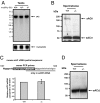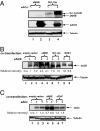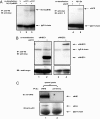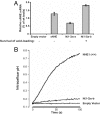A sperm-specific Na+/H+ exchanger (sNHE) is critical for expression and in vivo bicarbonate regulation of the soluble adenylyl cyclase (sAC)
- PMID: 17517652
- PMCID: PMC1890493
- DOI: 10.1073/pnas.0611296104
A sperm-specific Na+/H+ exchanger (sNHE) is critical for expression and in vivo bicarbonate regulation of the soluble adenylyl cyclase (sAC)
Abstract
We previously identified a sperm-specific Na(+)/H(+) exchanger (sNHE) principally localized to the flagellum. Disruption of the sNHE gene in mice resulted in absolute male infertility associated with a complete loss of sperm motility. Here, we show that the sNHE-null spermatozoa fail to develop the cAMP-dependent protein tyrosine phosphorylation that coincides with the functional maturation occurring upon incubation in capacitating conditions in vitro. Both the sperm motility defect and the lack of induced protein tyrosine phosphorylation are rescued by the addition of cell-permeable cAMP analogs, suggesting that cAMP metabolism is impaired in spermatozoa lacking sNHE. Our analyses of the bicarbonate-dependent soluble adenylyl cyclase (sAC) signaling pathway in sNHE-null sperm cells reveal that sNHE is required for the expression of full-length sAC, and that it is important for the bicarbonate stimulation of sAC activity in spermatozoa. Furthermore, both codependent expression and coimmunoprecipitation experiments indicate that sNHE and sAC associate with each other. Thus, these two proteins appear to be components of a signaling complex at the sperm flagellar plasma membrane. We propose that the formation of this complex efficiently modulates intracellular pH and bicarbonate levels through the rapid and effective control of sAC and sNHE activities to facilitate sperm motility regulation.
Conflict of interest statement
The authors declare no conflict of interest.
Figures






Similar articles
-
Depressing time: Waiting, melancholia, and the psychoanalytic practice of care.In: Kirtsoglou E, Simpson B, editors. The Time of Anthropology: Studies of Contemporary Chronopolitics. Abingdon: Routledge; 2020. Chapter 5. In: Kirtsoglou E, Simpson B, editors. The Time of Anthropology: Studies of Contemporary Chronopolitics. Abingdon: Routledge; 2020. Chapter 5. PMID: 36137063 Free Books & Documents. Review.
-
The sodium-proton exchangers sNHE and NHE1 control plasma membrane hyperpolarization in mouse sperm.J Biol Chem. 2024 Dec;300(12):107932. doi: 10.1016/j.jbc.2024.107932. Epub 2024 Oct 28. J Biol Chem. 2024. PMID: 39476963 Free PMC article.
-
Using Experience Sampling Methodology to Capture Disclosure Opportunities for Autistic Adults.Autism Adulthood. 2023 Dec 1;5(4):389-400. doi: 10.1089/aut.2022.0090. Epub 2023 Dec 12. Autism Adulthood. 2023. PMID: 38116059 Free PMC article.
-
Genedrive kit for detecting single nucleotide polymorphism m.1555A>G in neonates and their mothers: a systematic review and cost-effectiveness analysis.Health Technol Assess. 2024 Oct;28(75):1-75. doi: 10.3310/TGAC4201. Health Technol Assess. 2024. PMID: 39487741 Free PMC article.
-
Trends in Surgical and Nonsurgical Aesthetic Procedures: A 14-Year Analysis of the International Society of Aesthetic Plastic Surgery-ISAPS.Aesthetic Plast Surg. 2024 Oct;48(20):4217-4227. doi: 10.1007/s00266-024-04260-2. Epub 2024 Aug 5. Aesthetic Plast Surg. 2024. PMID: 39103642 Review.
Cited by
-
Molecular mechanisms of sperm motility are conserved in an early-branching metazoan.Proc Natl Acad Sci U S A. 2021 Nov 30;118(48):e2109993118. doi: 10.1073/pnas.2109993118. Proc Natl Acad Sci U S A. 2021. PMID: 34810263 Free PMC article.
-
An ion transporter in sperm that has features of a channel.Nature. 2023 Nov;623(7985):38-40. doi: 10.1038/d41586-023-03154-8. Nature. 2023. PMID: 37880527 No abstract available.
-
The control of male fertility by spermatid-specific factors: searching for contraceptive targets from spermatozoon's head to tail.Cell Death Dis. 2016 Nov 10;7(11):e2472. doi: 10.1038/cddis.2016.344. Cell Death Dis. 2016. PMID: 27831554 Free PMC article. Review.
-
Zinc: A Necessary Ion for Mammalian Sperm Fertilization Competency.Int J Mol Sci. 2018 Dec 18;19(12):4097. doi: 10.3390/ijms19124097. Int J Mol Sci. 2018. PMID: 30567310 Free PMC article. Review.
-
The Less Well-Known Little Brothers: The SLC9B/NHA Sodium Proton Exchanger Subfamily-Structure, Function, Regulation and Potential Drug-Target Approaches.Front Physiol. 2022 May 25;13:898508. doi: 10.3389/fphys.2022.898508. eCollection 2022. Front Physiol. 2022. PMID: 35694410 Free PMC article. Review.
References
-
- Garcia MA, Meizel S. Mol Reprod Dev. 1999;52:189–195. - PubMed
-
- Schackmann RW, Chock PB. J Biol Chem. 1986;261:8719–8728. - PubMed
-
- Woo AL, James PF, Lingrel JB. Mol Reprod Dev. 2002;62:348–356. - PubMed
-
- Bell SM, Schreiner CM, Schultheis PJ, Miller ML, Evans RL, Vorhees CV, Shull GE, Scott WJ. Am J Physiol. 1999;276:C788–C795. - PubMed
-
- Brett CL, Donowitz M, Rao R. Am J Physiol. 2005;288:C223–C239. - PubMed
Publication types
MeSH terms
Substances
Grants and funding
LinkOut - more resources
Full Text Sources
Other Literature Sources
Molecular Biology Databases

